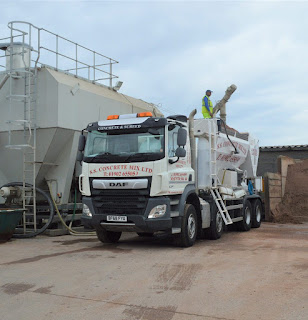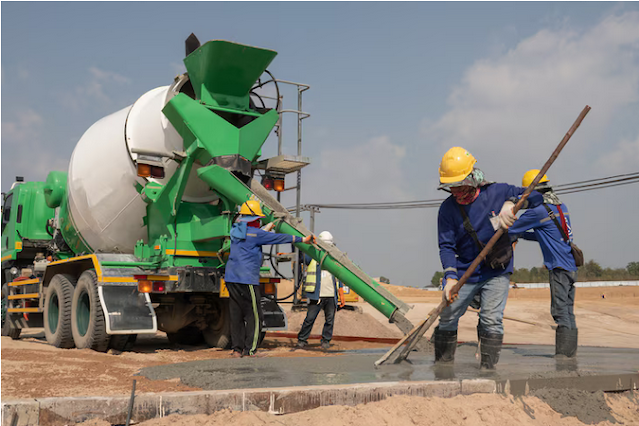Before ordering ready mixed concrete, here are a few things to keep in mind
Ready-mix concrete refers specifically to concrete which has been mixed with the stationary mix of the central mixing plant for batching and mixing. It is delivered to the client in a clean state. It is then delivered to the customer via a truck. The mix is then placed on a self-propelled chassis which will mix the concrete components while transporting. In the same way, ready-mix concrete is transported using the specially designed truck known as the transit mixer. The concrete is constantly rotated until the concrete is stable to use. i.e. placed. Ready-mix concrete is a fantastic alternative to conventional concrete mix. It takes less time and effort and is also less expensive. Ready-mix concrete is a distinct product because it ensures consistency throughout the process of construction and permits high-speed concrete construction. Ready-mixed concrete is able to eliminate issues like poor workability bleeding, the water-cement ratio and inadequate mixing time commonly encountered in traditional concrete mixes.
01. Mix or concrete grade design
Concrete types that you can use include flooring slabs, foundation slabs pavements, etc.
* You can indicate the type of concrete you require on the spot. M15, M20, M25, M30, etc
* Concrete slump both at the batching plant and on the site
* Volume of concrete measured in cubic meters.
* Concrete pouring address
* Ready-mix concrete is needed to be on site within a reasonable amount of time.
* The duration between the two consecutive delivery (in the case of a greater quantity i.e. greater Than 6 cubic meters
02. Fly Ash In excess Beware
It is crucial to know how much fly ash which has was included in the concrete. RMC producers can include a significant amount of fly ash in concrete, but this isn't suggested according to the guidelines. Fly ash is typically added to concrete in levels between 15% and 25% in the cementation component. This helps lower costs and improve profits for the plant's owners. Buyers must be aware RMC costs prior to purchasing it. Contact your dealer for this information prior to purchasing ready-mix concrete. I.e. Specifics of mixed designs
03. The source of the ingredients
Concrete components are bought from various source from RMC dealers. There are both good and bad sources. It is essential to evaluate the sources of every dealer. You can choose the ready-mix dealer only if its suppliers have a good reputation on their local marketplace for their quality.
04. Transport time
It is suggested to have ready-mix concrete supplier London be put in place within two hours from the moment of loading at central batching facilities. If admixture that retards concrete was used in the mix, it could be feasible to pour concrete over longer. But, it is essential to identify the retarder employed and to follow the instructions that are provided by the manufacturer.
05. Mixture
To enhance the concrete's working ability It is possible to mix an admixture to the concrete. Admixtures could contain chlorides. In these instances it is essential to know the proportion of total chloride contained in the mix. Concrete ready-mixed with excessive levels of chloride may cause corrosion and reduce the lifespan of the building. These admixtures shouldn't be utilized. In the present, nobody uses chloride-based admixtures.
06. Test of Concrete
Standard requirements dictate that concrete dealers who sell ready-mixed concrete must have the facilities for conducting routine tests on their facilities. Concrete slump tests and concrete cube testing are a few examples. This test allows you to check the strength and durability of the concrete that you've ordered. The test for slump can be performed on the spot to test concrete's ability to work. The concrete's slump is mostly dependent on its condition as well as the degree of workability needed. IS 456:2000 defines low-reinforced sections as beams, slabs and walls. Cast with a slump of between 25 to 75 millimeters. Sections with a strong reinforcement like beams, slabs, walls columns, walls, and others can endure high loads. The cast is poured with a slump of 50 to 100 millimeters. Formwork slips and pumped concrete need a slump between 75 and 100 millimeters.
07. Traffic Problem
A few city police officers have developed new regulations to ease traffic congestion and to prevent accidents on the road. They have imposed restrictions on moving of items as well as large vehicles in peak times to make roads clear. If you live in a city, it's essential to make concrete pouring plans in line with these traffic regulations.
08. Information on the Delivery Ticket in relation to Ready Mix Concrete
This information must be included on the ready-mix concrete batch's delivery ticket:
Name and number of the concrete plants that mix ready-mixed
* The date and the serial numbers
* Number
Address and name of buyer
* Concrete grade
* Mix design details
* Table format
* Size and type of concrete materials
* Concrete volume per cubic meter
* Time taken to load
* The result of a batching plant is the formation of a slump
* The signature of the concrete plant's operator
On site, you'll need to fill in the following form for Premix Concrete Tickets
* Time of arrival
* When the discharge was completed
* Any water/admixture or is added to this site
* Concrete pouring location
Results of Slump tests are available at the website
* Signed by RMC receiver
Concrete is getting more and more sought-after each day, however it comes with a significant environmental cost. Natural materials are extracted and processed on a daily basis. This could have an adverse impact on the environmental. There was a way to improve the value of concrete ready-mixed by studying the characteristics of waste materials and products like fly ash. This is a sign that we are aware of the negative effects of unhealthy surroundings in our environment and we are going towards more green materials, which can help make green buildings.




Comments
Post a Comment